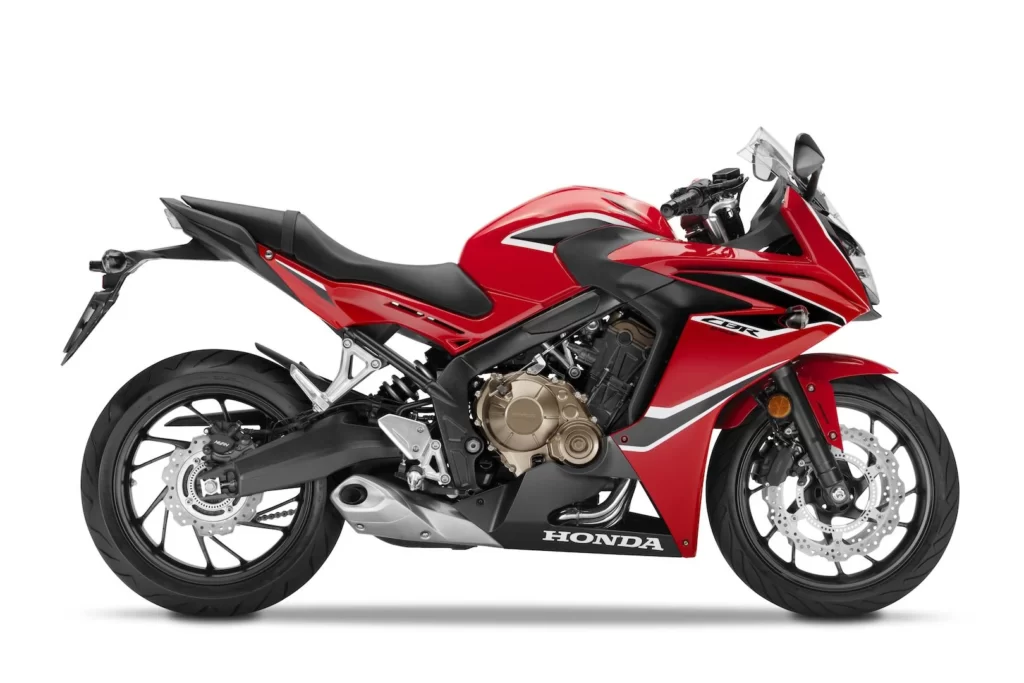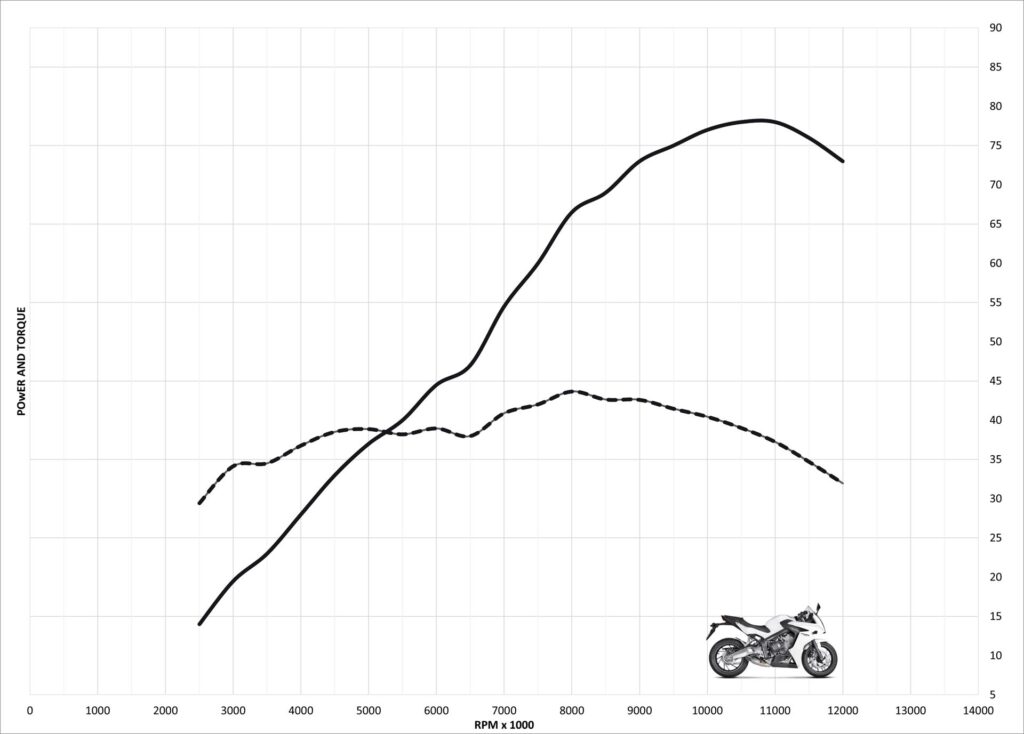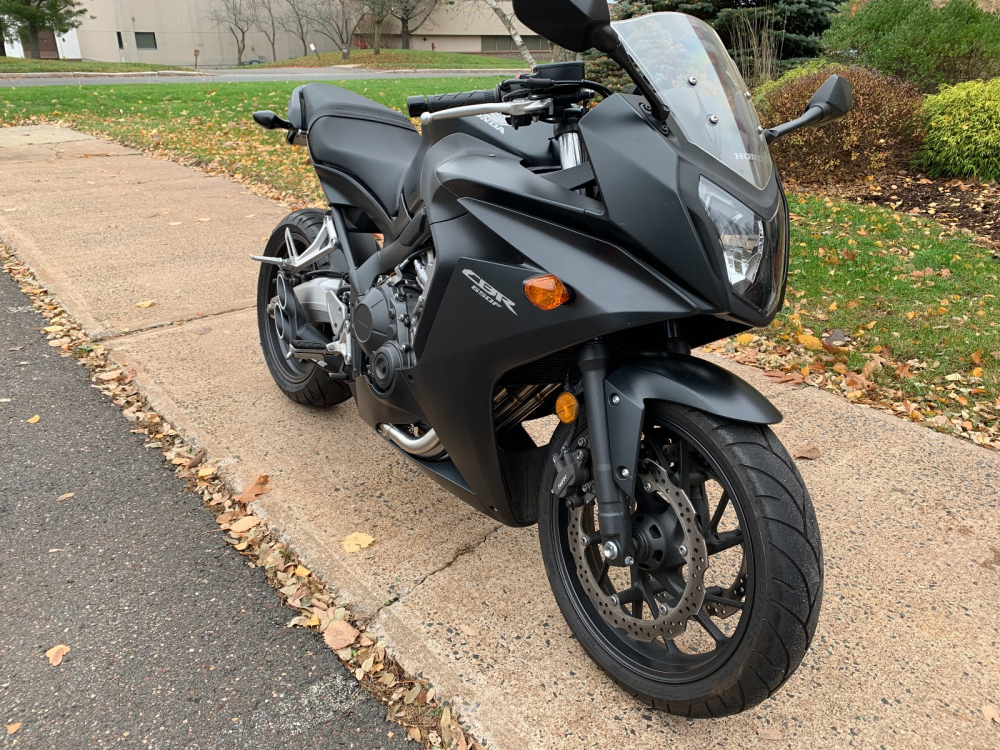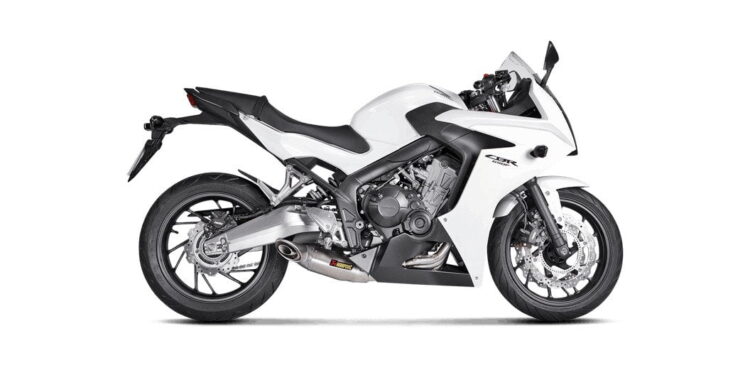Honda CBR650F 0-60 mph in 3.50 seconds
The Honda CBR650F has been with us since 2014 and was supplanted by the Honda CR650R in 2019.
This machine arguably was a spiritual successor to the very popular and capable Honda CBR600F4i
Arguably, the Honda CBR650R is less sporty and more learner and touring-focused. It’s equipped with lower pegs and higher bars for more comfort.
There was a softer and less popular Honda CBR600F that ran from 2011 to 2013 but that model, despite being a good motorcycle in its own right, never quite caught on as the original F4i did.
The Honda CBR650F was the replacement of the 600F and was at the time the latest incarnation of the middleweight CBR.
The engine grew from 599 cc to 648 cc, and it came with around 20 hp less and carried more weight than the 11-13 Honda CBR600F.
Not to mention the F4i which is even more powerful and lighter.

It certainly seems that Honda took another step backward.
At least on paper, it was a step back from the model it directly replaced, as well as the original Honda CBR600f4i.
That motorcycle offered Supersport performance with the all-around city and touring ability.
The entry-level and learner markets have been hanging and perhaps Honda saw the CBR650F as fitting better in that niche.
Perhaps as a result of that direction choice, the Honda CBR650F went even softer than the CBR600F but that fact did not dissuade buyers as the CBR650F has been an extremely popular motorcycle with new and existing riders.
Even if it has less power than those models it was expected to replace not only literally but, in the hearts, and minds of riders.
With the above in mind, how fast does the Honda CBR650F accelerate from 0-60 or 0-100 and so on and how much power does it produce?

Honda CBR650F dyno and engine performance
The HondaCBR650R makes a respectable 78 hp at around 10,500 rpm which is a little shy of the model it replaces.
Do not let that put you off too much, because that extra 49 cc does make up for it.
The engine does produce a wider spread of power and torque through the entire range than both the Honda CBR600F and quite a bit more than the Honda CBR600F4i.
Peak torque is 44 ft/lb which is met at 8000 rpm. This is the point where the engine really wakes up and comes on cam where gets a move on.
Below 8000 rp the Honda CBR650F’s engine provides a flat and linear torque curve where it averages out at around 37 ft/lb pretty much between 4000 and 6000 rpm.

This figure is only 7ft/lb off the maximum of 44 ft/b and is quite impressive for a sub 700 cc inline four-cylinder.
Between 4000 and 600 rpm is the part of the range you’ll most likely find yourself in when riding on the street. You’ll get a smooth, predictable, and effortless overtaking grunt.
Low-end is certainly not class-leading for the 600-700 cc segment but there.
What is certain is that there more than enough poke to leave the Honda CBR650F in a higher gear and use the torque that’ll have you covered for all but the most urgent overtaking manouvers.

Honda CBR650F in-gear performance
Like all 4-cylinder motorcycles, the Honda CBR650F still likes to be thrashed into the red and beyond
While it does not rev to the astronomical highs of 15000 rpm plus as many motorcycles do in the Supersport class, the Honda CBR650F still shows its Supersport lineage and will willingly enjoy being thrashed.
The engine does pick up nicely at around 6500 rpm all the way to around 12000 rpm. It offers that familiar 4-cylinder scream that we all enjoy and know so well.
The Honda CBR650F may not pull from 8000 rpm up like a Supersport, but Honda CBR650F still has that turbine linear build of power that will certainly get you going and raise your levels of excitement.
An ECU flash and Decat exhaust will give the CBR650F that race bike sound while also taking the power up to around 85 horsepower at the wheels.

CBR650F 0-60 and 0-100 times to top speed
Just like all middle-weight motorcycles the Honda CBR650F is objectively quick and will beat or equal many Supercars and Sports Cars from both the 60 mph and 100 mph sprint from zero.
Just how fast is the Honda CBR650F from 0-60 mph….? Well, it’s quick and manages 0-60 mph in 3.51 seconds and 0-100 km/h in 3.67 seconds.
The clutch is light and smooth and while the Honda CBR650F will indeed wheelie, its porky but manageable weight and ease of use ensure that it launches easy and consistently.
The 0-60 mph time could be quicker but you have to literally hit the limiter in first which is around 59.7 mph.
Unfortunately this means that you need to engage second gear to hit 60 mph where you’ll lose a few tenths due to the gear change.
Funnily enough, if the Honda CBR650F had gearing that was a tiny fraction longer the 0-60 mph would be potentially 0.20 seconds faster as you’d not require the time-killing gear change.
It’s not done there and continues to charge pretty hard and manages 0-100 mph in just 7.90 seconds.
For the Quater Mile, the Honda CBR650F achieves a very decent 11.75 seconds @ 117 mph. This time isn’t quite Supersport challenging and quite a way off one of the fastest in that class, the Yamama YZF-R6.
A sub-eleven-second time across the quarter mile is still very impressive.
The metric 0-200 km/h benchmark takes the Honda CBR650F only 14.93 seconds.
The Honda CBR650F is generally not too fussy at what rpm you change gear for the best ETs so anywhere between 10,500 and just before the limiter will yield consistent times.
It’s just down to your preferences in the moment!

0-130 mph is achieved in 17.16 seconds at which point the Honda CBR650F starts to relent with its acceleration as the air starts to make it presence known.
If you want to accelerate beyond this point you better tuck and make yourself small as you slowly make progress to the Honda CBR650F’s top speed.
For normal riding around the Honda CBR650F has plenty of power available to accelerate at will.
For example, at highway speeds, there is no need to change down a gear as 6th is more than enough to blast past slow-moving cars.
If you really got to go you could even use 2nd gear, but rpm would be pretty high, so third gear should be used if you really have somewhere to be on time and the Honda CBR650F will respond willingly.
Honda CBR650F’s top speed is 139.1 mph
The Honda CBR650F offers decent wind protection and although not class-leading it is better than your average Supersport bike by a mile.
But like all motorcycles, you must work on your Yoga positions so you can get all your body parts out of the worst that the elements have to offer.
Do this and you’ll definitely net a few for mph top speed.
We managed 139.1 mph which is a little slower than the HondaCBR650F’s replacement the CBR650R which hit 144 mph.
This makes sense as the R version is a little more powerful.
The Honda CBR650R does have a smaller frontal area, though it also has a smaller less protective screen and front fairing. This ensures that it is harder to get out of the wind.
Both would benefit from a bigger/taller screen that offers more protection.
In most day-to-day weekend blast situations, you’ll be hitting 120-30 mph if you are not committed to a full tuck.
As per the acceleration numbers, the Honda CBR650F does not disappoint and will get there pretty quickly.
The CBR650F from a performance perspective is very much like the Honda CBR650R just with a little less power, and a little more weight.
It more or less accelerates a little slower and loses out at the top by around 5 mph. Lower down the the CBR650F may have a little more initial performance.
If you want a comfortable, fast, and fun bike that will tour and commute, but still provides enough engine performance to play with your friends or upset sports cars. The CBR650F is a great choice
It’l also put a smile on your face, especially if you are a new rider and this is your first big bike.
It is a great choice of motorcycle in a sea of great choices in the busy entry-level sportbike class.
| Honda CBR650F Acceleration | |
| Speed | Time |
| 0-10 mph | 0.4 |
| 0-20 mph | 1.08 |
| 0-30 mph | 1.62 |
| 0-40 mph | 2.17 |
| 0-50 mph | 2.70 |
| 0-60 mph | 3.50 |
| 0-70 mph | 4.28 |
| 0-80 mph | 5.15 |
| 0-90 mph | 6.53 |
| 0-100 mph | 7.90 |
| 0-110 mph | 10.10 |
| 0-120 mph | 12.66 |
| 0-130 mph | 17.61 |
| 60-120 mph | 9.15 |
| SS/QM | 11.75/117 mph |
| SS/KM | 22.23/136 mph |
| SS/Mile | 32.00/138 mph |
| Top Speed | 139.1 mph |


















